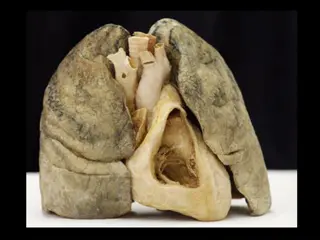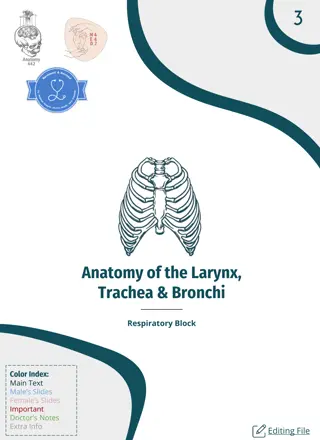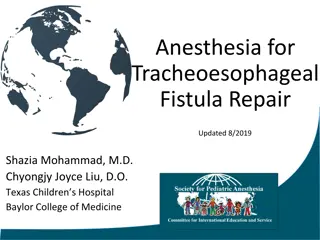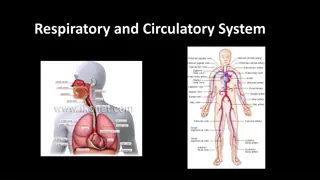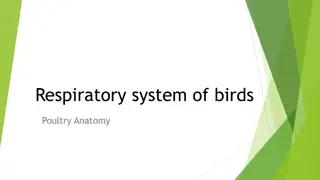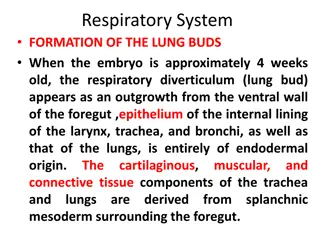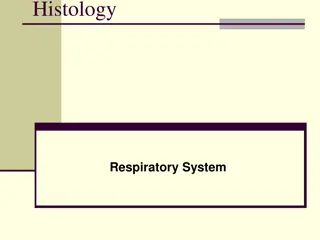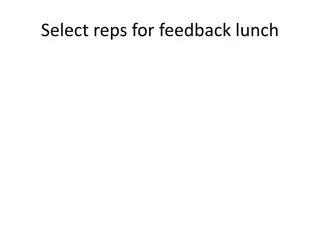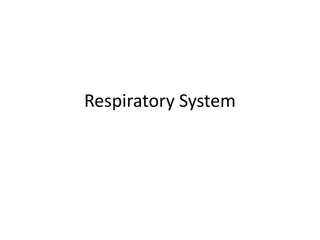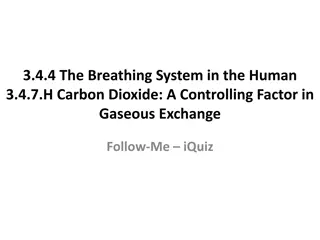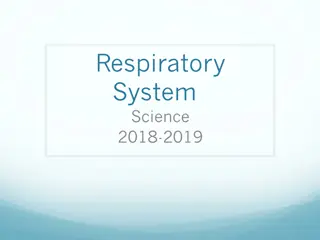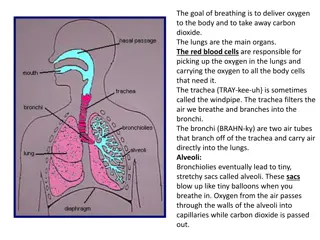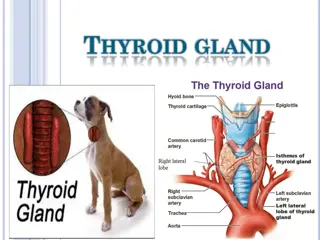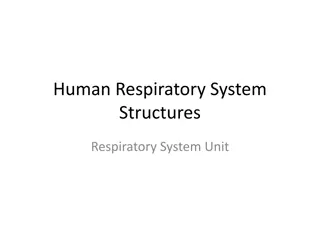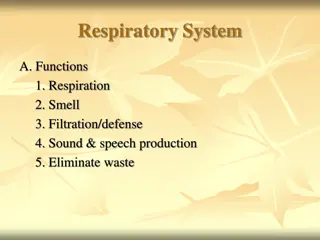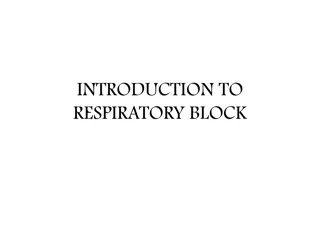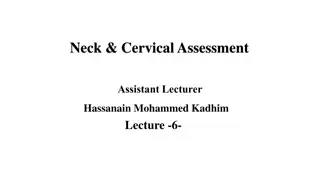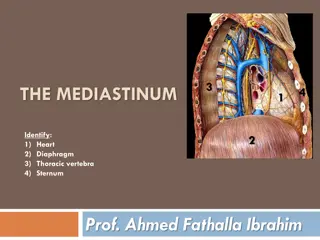Functions of the Respiratory System and Ventilation Mechanism
The respiratory system performs crucial functions such as ventilation to facilitate gas exchange, maintaining pH balance, and enabling vocal sounds. It consists of the upper and lower respiratory systems, including structures like the nose, trachea, bronchi, and alveoli. The system's epithelium, the
7 views • 43 slides
Anatomy of the Larynx, Trachea, and Bronchi: Respiratory System Overview
The larynx, trachea, and bronchi are vital structures of the respiratory system with distinct functions and anatomy. The larynx houses vocal cords, aids in breathing, voice production, and swallowing. It is interconnected with major arteries, veins, and nerves in the neck. The trachea extends from t
12 views • 19 slides
Anesthesia Considerations for Tracheoesophageal Fistula Repair
Tracheoesophageal fistula (TEF) is a rare abnormal connection between the esophagus and trachea, often associated with congenital anomalies. This article covers TEF clinical presentation, prevalence, diagnosis, management, and anesthesia considerations. Understanding TEF and its related syndromes is
0 views • 29 slides
Understanding the Respiratory System and its Vital Functions
The respiratory system plays a crucial role in our bodies by taking in oxygen and expelling carbon dioxide. Key components include the lungs, diaphragm, bronchi, and alveoli. Air enters through the nose or mouth, travels down the trachea to the lungs, where oxygen is absorbed into the bloodstream an
0 views • 26 slides
Anatomy of the Respiratory System in Birds: A Detailed Overview
The respiratory system in birds, including poultry, consists of various components such as nostrils, nasal cavities, larynx, trachea, syrinx, air sacs, and lungs. Each part plays a crucial role in respiration, with unique features adapted to avian physiology. Understanding the anatomy of the avian r
0 views • 19 slides
Development of the Respiratory System in Human Embryos
The formation of the lung buds, larynx, trachea, bronchi, and lungs in human embryos involves complex processes where various structures develop from different tissue origins. The lung buds arise from the ventral wall of the foregut, while the larynx, trachea, and bronchi epithelium are of endoderma
7 views • 19 slides
Cockroach Respiratory System Overview
Cockroach respiratory system is tracheal-based, featuring stigmata for gas exchange. Trachea lead to tracheoles for oxygen transport to tissues. Tergo-sternal muscles aid in respiration, with inspiration expanding the body cavity for air intake and expiration expelling CO2. Control of respiratory mo
0 views • 8 slides
Overview of Mammalian Respiratory System Histology
The respiratory system in mammals functions to warm, humidify, and cleanse the air as it travels from the nostrils to the lungs. It comprises the nasal cavity, pharynx, larynx, trachea, bronchi, and bronchial tree. The epithelial linings vary in different parts, containing specialized cells and glan
0 views • 14 slides
Understanding the Respiratory System Components and Functions
The respiratory system consists of two primary subdivisions: the Air Conducting portion and the Respiratory portion. The Air Conducting portion includes nasal cavity, naso-pharynx, larynx, trachea, bronchi, bronchioles, and terminal bronchioles, providing a pathway to and from the lungs while condit
0 views • 12 slides
Understanding Nasal Cavity Histology and Respiratory Structures
The detailed information provided covers the histological structures of the nasal cavity, including the vestibule, respiratory mucosa, nasal septum, olfactory mucosa, and paranasal sinuses. It also delves into the microscopic structures of the wall of the trachea and primary bronchi. The respiratory
0 views • 11 slides
Respiratory Tract Anatomy Overview
The respiratory tract anatomy includes various structures like mucosa, submucosa, and adventitia in the trachea, bronchi, bronchioles, and terminal bronchioles. Each component has specific compositions and functions, ranging from respiratory epithelium to smooth muscle layers. The images provide a v
0 views • 15 slides
Select Reps for Feedback Lunch
This collection features detailed images of various types of epithelium found in different parts of the body, including the bladder, submandibular gland, ileum, uterine tube, esophagus, skin, foot, and trachea. Each image provides a close-up view of the epithelial tissue and surrounding structures,
0 views • 16 slides
Understanding the Respiratory System and Its Functions
The respiratory system is vital for gas exchange in the body, involving processes like pulmonary ventilation, external and internal respiration. It includes organs like the nose, pharynx, larynx, and trachea, which help in conducting air to the alveoli. This system facilitates the exchange of oxygen
1 views • 14 slides
Understanding the Breathing System in Humans
Explore the intricacies of the human breathing system, including the role of carbon dioxide in gaseous exchange. Test your knowledge with interactive quizzes and learn about the functions of different respiratory components such as the larynx and trachea. Dive into topics like breathing rates, gas e
0 views • 50 slides
Understanding the Respiratory System and the Process of Respiration
The respiratory system is vital for breathing as it helps in the exchange of oxygen and carbon dioxide. This system consists of organs such as the lungs, bronchi, and alveoli. The process of respiration involves inhaling air through the nose or mouth, passing it through the trachea and bronchi into
0 views • 5 slides
Understanding the Importance of Breathing and Respiratory System
Breathing plays a crucial role in delivering oxygen to the body and removing carbon dioxide. The respiratory system, including the lungs, trachea, bronchi, and alveoli, functions to facilitate this vital process. The diaphragm muscle helps in inhaling and exhaling, while the exchange of oxygen and c
0 views • 14 slides
Understanding the Thyroid Gland: Structure, Hormones, and Function
The thyroid gland, a butterfly-shaped structure located on the ventral surface of the trachea, secretes hormones essential for regulating metabolic rate, growth, and development. It produces hormones like Tetraiodothyronine T4, Triiodothyronine T3, and Calcitonin, which play crucial roles in maintai
0 views • 21 slides
Exploring the Human Respiratory System Structures
Delve into the intricate structures of the human respiratory system, from the essential organs like the lungs and diaphragm to the pathways such as the nasal cavity, mouth, pharynx, and trachea. Learn about the functions of key components like the epiglottis, larynx, bronchi, bronchioles, and alveol
0 views • 12 slides
Overview of the Respiratory System Functions and Anatomy
The respiratory system has vital functions such as respiration, smell, filtration/defense, sound & speech production, and waste elimination. It consists of external (root, bridge, apex, and nostrils) and internal components (nasal cavity, pharynx, larynx). The nose/nasal cavity provides an airway fo
0 views • 37 slides
Comprehensive Overview of Respiratory Block for Medical Students
This respiratory block introduces students to the anatomy, histology, muscles involved in respiration, embryology, radiological anatomy, and management of respiratory disorders. It covers topics like the nasal cavity, pharynx, larynx, trachea, bronchi, lungs, pleura, bronchial tree, and mediastinum.
0 views • 23 slides
Comprehensive Guide to Neck and Cervical Assessment by Hassanain Mohammed Kadhim
Learn how to inspect the neck for appearance and movement, differentiate between normal and abnormal findings, and perform palpation techniques for the trachea, thyroid gland, and cervical lymph nodes. Discover the important landmarks and characteristics to assess during a neck examination.
0 views • 13 slides
Understanding the Mediastinum: Boundaries, Divisions, and Contents
The mediastinum serves as a vital partition in the thoracic cavity, housing various structures between the pleural sacs. Divided into superior and inferior regions, it encompasses essential organs such as the heart, thymus, major blood vessels, nerves, trachea, esophagus, and lymph nodes. Exploring
0 views • 25 slides
